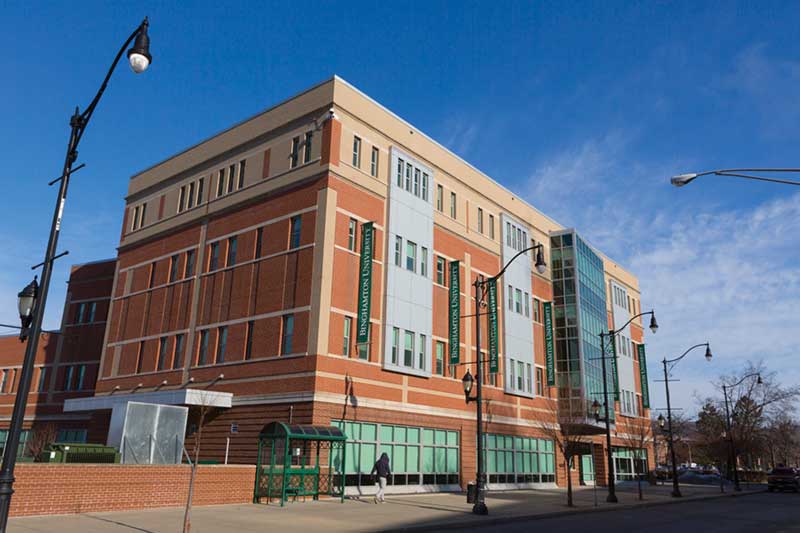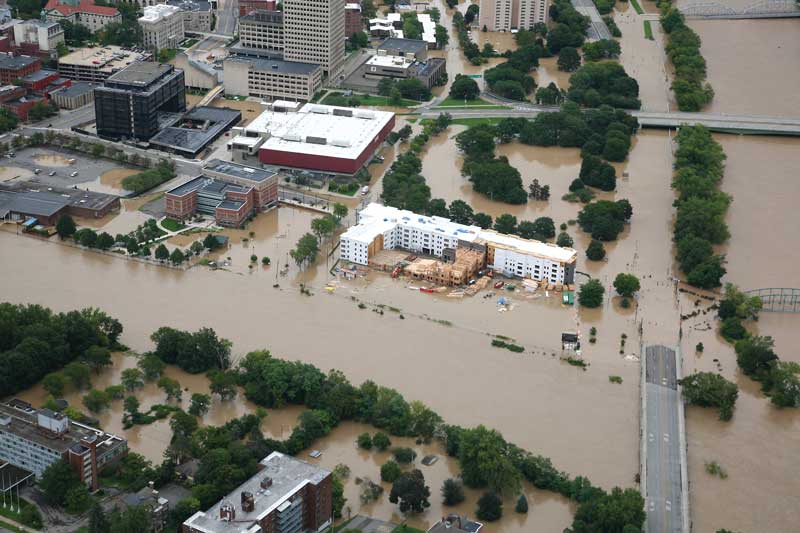The story, so far
The College of Community and Public Affairs (CCPA) turns 10 in July

In July 2006, the College of Community and Public Affairs (CCPA) was formally spun off from the reorganization of the School of Education and Human Development. The new college, comprised of departments in public administration, social work and human development, spent its first year housed in the Academic B building on campus.
A year later, CCPA moved into its new 74,400-square-foot home on Washington Street in downtown Binghamton — the first time Binghamton University had expanded beyond the Vestal campus.
In celebration of its 10-year anniversary, 10 people share their memories of CCPA’s beginnings.
Mary Ann Swain, then-provost and vice president of academic affairs; currently director of the doctoral program in the Decker School of Nursing and interim chair of the Department of Student Affairs Administration: “The proposal to form a separate School of Education and a new College of Community and Public Affairs was submitted in 2005. As the provost, I saw this reorganization as a fortuitous opportunity to rethink how academic units should be structured around common missions and identities. The core of CCPA has always been using intellectual work to improve individual lives and communities. While it may seem like the departments are separated, this is the common theme that runs through all of them.”
Patricia Ingraham, founding dean of the College of Community and Public Affairs: “My first year as dean was spent convincing existing departments that had never collaborated why it would be positive to form a college. We had to build an organizational culture from the ground up, create a new management structure and define who we were as a college.”
Swain: “I pitched starting CCPA to Pat as ‘a chance to create something that doesn’t exist anywhere else in this country, or in any country for that matter.’ This particular set of intellectual programs, coming together in a location immersed in the local community — a lot of academics would love that kind of opportunity.”
Laura Bronstein, current dean of the College of Community and Public Affairs, professor of the Department of Social Work: “I started with the University in 1999 as a human development faculty member to help develop its social work program. I always knew that I was here to help build something bigger.”
Robert Langhans, architectural project coordinator for Binghamton University:“Building the University Downtown Center was a long, involved process. We had special funding from Sen. [Thomas] Libous, and the intent was to put a home for CCPA in downtown Binghamton. At the time, there was controversy that Binghamton University students did not explore the surrounding community.”
Strengthening town-gown ties
Ingraham: “A lot of elected officials and community members had a say in what purpose the University Downtown Center was going to serve. When the decision was made to house CCPA downtown, there was no question that the downtown center was going to be an academic building first and foremost.”
Langhans: “One of the goals of the University Downtown Center was to help gentrify the downtown area. The intent was never to compete with downtown, but to have the faculty, students and staff want to eat at local restaurants, go to nearby museums and support local businesses.”
Swain: “It is a very modern building in appearance, but the architects wanted the downtown center to fit in with the rest of Washington Street. I was instrumental in having the first floor reflect the village that was found onsite as a way to embed the history that was here long before us.” (See inside cover for more about the story behind the floor).
Joann Lindstrom, MPA ’07, director of recruitment and internship placement, Department of Public Administration: “Before moving downtown, our classes were spread across the Vestal campus. I remember coming to the new building and thinking how clean and modern everything felt. It makes a huge difference to be housed in one building and feels more like a student-centered, community environment.”
Sylvia Kerber, local business owner and community member: “I remember when the University Downtown Center first opened: The new building symbolized an awakening for the City of Binghamton.”
Ingraham: “It was very brave of the faculty and staff to leave Vestal and go downtown. Nobody likes to feel separated from the rest of the campus. From setting up our library to making sure there was a place for students to buy coffee to determining an efficient bus schedule, there was a collaborative, high-quality effort to open the University Downtown Center.”
College of connections
Ingraham: “It was very brave of the faculty and staff to leave Vestal and go downtown. Nobody likes to feel separated from the rest of the campus. From setting up our library to making sure there was a place for students to buy coffee to determining an efficient bus schedule, there was a collaborative, high-quality effort to open the University Downtown Center.”
Kerry Stamp ’08, MPA ’09, CPA PhD candidate, associate director of Study Abroad for Binghamton University: “I came to Binghamton as an undergraduate student, without any plans of staying here after graduation. However, that is just what I ended up doing, and mainly because of the connections that I made through the MPA program.”
Suzanne Cardona Meyer, MSW ’07, CCPA Board of Visitors member: “In 2005, I was primarily job searching. I didn’t even know that Binghamton had an MSW program. Within one week, I applied to the program and was accepted, which was the best thing that ever happened to me.”
Ivy Smith ’09, MS ’11, coordinator of the Binghamton University McNair Scholars Program: “Before visiting, I had never heard of Binghamton. I stumbled upon human development and read the description and thought ‘this is exactly what I want, this is amazing.’”
Swain: “There is a lot of overlap between the programs. Public administration involves the implementation of new policies, which informs social work in terms of how adequately these structures serve individual lives. Human development runs through all of the departments. Student affairs administration is the community-focused enterprise within higher education.”
Smith: “As a senior, I remember doing the assigned readings and thinking to myself, ‘These descriptions are all of the things I went through growing up.’ Before my education at CCPA, I never knew there was literature about my experiences or theory to back up what I was going through.”
Lindstrom: “In 2008, we showed [President Barack] Obama’s inauguration in the first-floor lobby and so many people came to watch. Obviously, it was a big deal to inaugurate the country’s first black president. Dean Ingraham and the college always took the time to recognize major markers like that, and the impact those events had on us.”
Ingraham: “An informal milestone for me occurred one morning when I was talking to security guards at the University Downtown Center. A bus pulled up from the main campus, unloaded students, and students from the downtown center then filled the bus for the trip back to the main campus. This memory signified to me that the University had students living and studying downtown, just as much as they were living and studying in Vestal. Our college was playing a role in serving this downtown population.”
Bronstein: “Internships and field work are a core part of our educational mission as a college. We have so many community members — literally hundreds each semester — who are volunteering their time to supervise our students.”
Luann Kida, MA ’03, director of the Broome County Promise Zone: “Today at the college, I believe there is more opportunity than ever for students to contribute to the community and work those experiences into their degrees.”
Bronstein: “Our faculty members merge their research, teaching and service — it’s a defining part of our college. This approach also demonstrates to students that what they are being taught in the classroom is applicable in the community.”
Turbulence and triumph
Lindstrom: “Individuals in our college have experienced a lot of good times and a lot of challenges over the years. It really felt like CCPA was on the front lines of the American Civic Association shooting in 2009 and the flood in 2011.”
Ingraham: “When the floods occurred, CCPA really demonstrated that we were a college and a single unit. We moved everyone out of the University Downtown Center two days after the floods — that is almost unheard of for any building evacuation.”
Roberta Brundege ’07, assistant to the dean: “After the flood, students were very reluctant to leave downtown Binghamton. After having to work through the challenges of leaving the Vestal campus in 2007, we were addressing new concerns from students and faculty with leaving downtown in 2011. This emphasized a shift in mindset about our location downtown.”
Ingraham: “We operated under those circumstances for a year. When classes resumed across the University a week after the flood, all of our courses were in session in any available space on the Vestal campus.”
Ingraham: “Something that is overlooked is that the downtown center is a very special location. CCPA received the artifacts and a blessing from the Native American nation that was here before. These artifacts are a permanent fixture in the building, too.”
Local, lasting impact
Lindstrom: “Today, I tell prospective students you never have to go to the main campus for a book, our building has state-of-the-art technology and buses from downtown run every 15 minutes.”
Smith: “If someone had told me when I started as a human development major that I eventually would get my master’s in student affairs administration and be working on campus, I would have said, ‘No way.’ I also teach a student affairs administration course, so I’ve really come full circle. The CCPA faculty and staff have always been supportive.”
Bronstein: “I hope as we continue to grow that we can continue to have a positive impact on the community and that Binghamton increasingly becomes a place where people want to live and work after graduation.”
Lindstrom: “When you look at local government and nonprofits in our region, our alumni numbers keep growing. And on campus, we have a very strong alumni base.”
Stamp: “Today, I’m proud to help build study-abroad experiences for CCPA students. An international experience is valuable in preparing students who will enter the field of public service, and helping to make this a reality for CCPA students has been a way that I am able to contribute to this school.”
Ingraham: “What changed the most about CCPA between when I started as dean and when I was preparing to retire was the recognition that we became a part of Binghamton University and of the local area. It’s hard to balance an off-site campus while maintaining a presence at the University.”
Lindstrom: “It’s starting to feel like we’re 10. We definitely have a history and have developed our own culture.”
Bronstein: “If I worked at a university, college or department that had been around for 100 years, I would find new and interesting things to do. But what I love about CCPA is that the past 10 years have always been all about growing and developing. The people who are a part of CCPA are here because they want to be innovative and trailblazers.”











